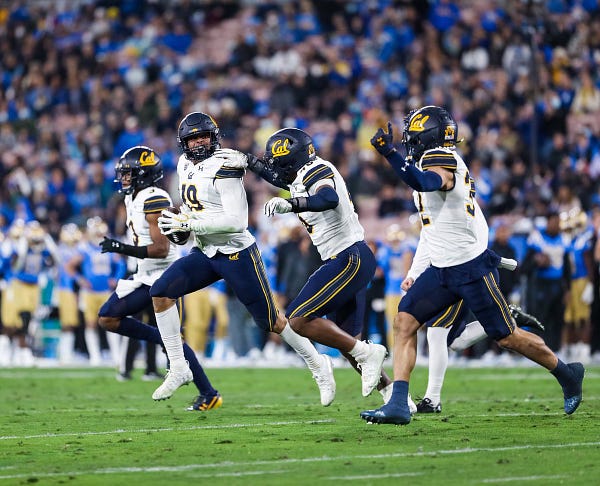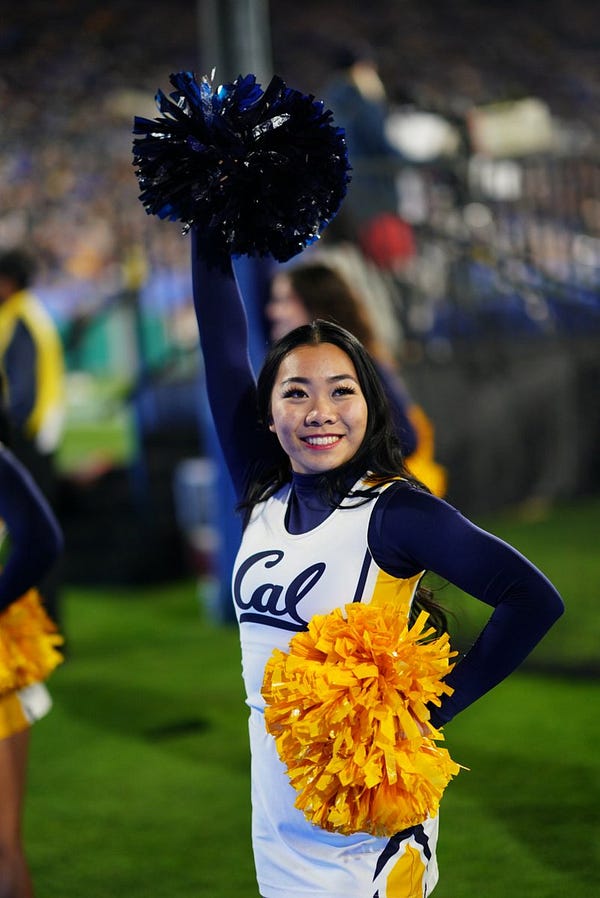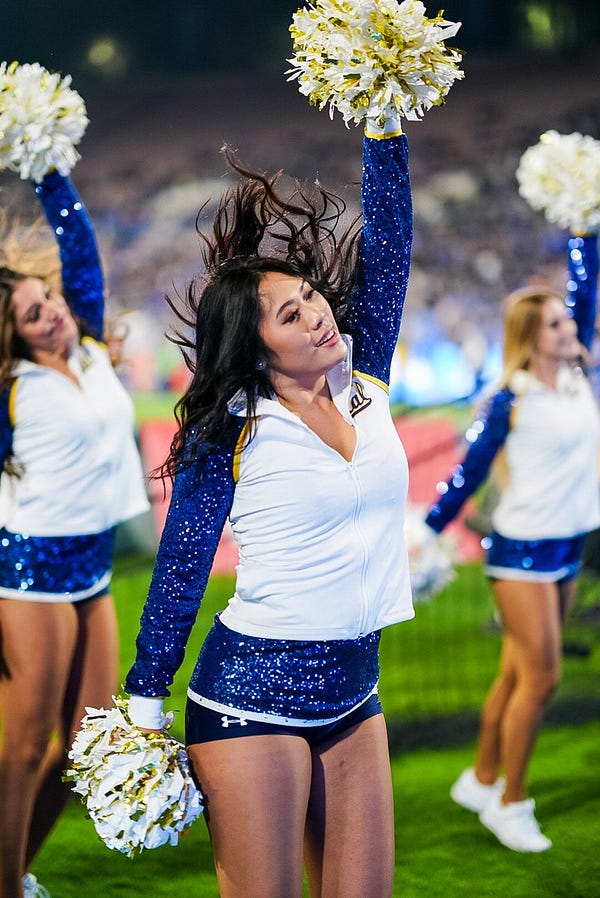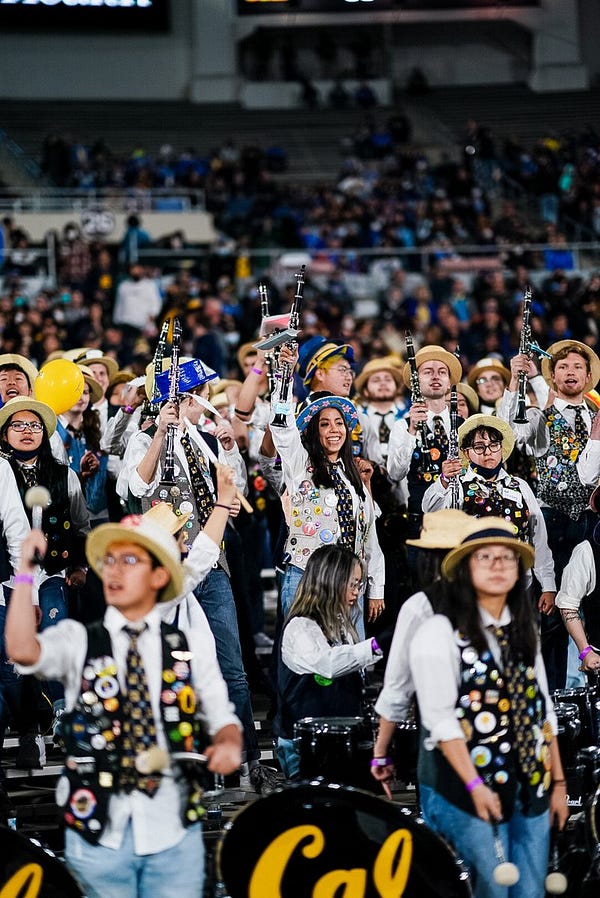Post-Game Thoughts: UCLA Football
Cal is eventually overwhelmed on both sides of the ball in a demoralizing defeat in Los Angeles
What is it about UCLA, exactly?
Justin Wilcox doesn’t get blown out a ton. When you’re a defensively minded head coach, you can often keep a game close (even superficially) despite a misfiring offense. Sure enough, Cal has only lost 8 games out of 53 under Justin Wilcox by 17 or more points. Five of those have come against names you might expect - Oregon twice, plus one each against UW, Utah, and USC. Most of those teams were really good teams.
Those other three blowouts? 34-10, 37-7, and now 42-14 to UCLA.
At least this year’s version of UCLA is on the upswing. 8-4 isn’t mind-blowing, but it’s better than the 3-9 team that crushed Cal in 2018 or the 3-4 team that blew Cal out last year.
But Cal’s record and UCLA’s record don’t appear to be particularly relevant. Chip Kelly is now 3-1 against the Bears, and those three wins were not at all close.
Not every defeat has been the same; 2018 was largely about turnovers (-5 will get you blown out most of the time). But 2020 and 2021 were about Cal’s offensive line getting blown up by a defensive front that doesn’t really do the same thing to anybody else.
I don’t get it.
Offense
Efficiency Report
11 drives: 2 touchdowns, 0 FGA, 4 punts, 4 turnovers (2 interceptions, 2 downs), 1.3 points/drive
And honestly, 1.3 points/drive is generous because it gives Cal’s offense credit for cashing in on a 13 yard drive set up by a weird special teams play. The Cal offense sustained drives exactly twice: once on their first touchdown drive that featured one huge 3rd down conversion throw and then a bunch of running, and once on a pointlessly hilarious 18 play (but really 20 counting plays cancelled by penalty) garbage time 4th quarter drive that ended in a failed 4th and 1 conversion at the UCLA one.
What happened to Cal’s pass protection, Part II
Back in early October, Cal suffered an ugly loss to Washington State primarily caused by a complete inability to protect Chase Garbers
That pressure completely disrupted Cal’s offense. Here’s a free preview of this week’s PFF post:
Give Chase time and Cal moves the ball like a slightly above average college offense. Put Chase under pressure and everything is broken, and Cal could barely keep the pocket clean more than half the time.
Unfortunately, it happened again:
This time around Chase wasn’t particularly effective even when kept clean. The other difference? Against Wazzu it was all edge pressure, but this time around the pressure was more or less coming from everywhere, including straight up the gut. 10 different Bruins recorded a pressure, and Cal allowed a pressure event on 43% of their drop backs.
Pass protection has been the single most inconsistent aspect of this Cal team, and Cal’s ability (or not) to protect Chase Garbers is probably the single thing I’ve seen most correlated to offensive success or failure.
Defense
Efficiency Report
9 drives: 5 touchdowns, 2 FGA (2-2), 2 punts, 0 turnovers, 4.7 points/drive
(Removed: UCLA’s final drives of each half; one was a free hail mary after an interception, the other an exercise in clock killing.)
While watching the game, my impression was that the defense was playing reasonably well considering they were getting next to zero support from the offense, and it’s certainly true that UCLA ran 22 more plays than Cal before garbage time drives.
And yet, when you get to the final numbers, you see that UCLA produced an absurd 4.7 points/drive. Getting that many points on a good-but-not-dominant 6.2 yards/play was only possible because Cal did a pretty good job forcing UCLA to drive the field on multiple plays . . . which UCLA did quite easily by converting 9 of 13 on 3rd down.
To be fair to the Cal defense, they allowed a reasonable 4.4 yards/play on UCLA’s first five drives. But once UCLA got rolling it was all over as the Bruins scored on 4 straight drives averaging a painful 8.9 yards/play. Whether it was exhaustion, demoralization, or UCLA dialing in on the right moves schematically, Cal’s defense couldn’t stand up to the onslaught.
No answer for DTR
While Cal’s offense featured an ineffective Chase Garbers running for his life, UCLA enjoyed the final home game from Dorian Thompson Robinson. I’ve joked as recently as earlier this year that DTR is my favorite chaos agent, a live wire of big plays and weird decisions and elusiveness and random fumbles.
Unfortunately for my entertainment, and unfortunately for the Pac-12 generally and Cal specifically, DTR has really ironed a lot of those issues out of his game, and he was in complete control. Passing, extending plays, scrambling, name it and he did it at a very high level.
Special Teams
Two huge plays
On another day, we might have been talking about how Cal special teams finally swung a game from defeat to victory. Nikko Remigio’s 58 yard kickoff return and Cam Goode’s hustle fumble recovery on a UCLA muffed kickoff could have been decisive.
Alas, the Cal offense only cashed in on one of those two opportunities, and UCLA’s dominance on both sides of the ball meant that even the most extreme special teams variance wasn’t going to impact this game.
Coaching/Game Theory
Are we trying to score, or not?
Late in the 2nd quarter, UCLA is in the middle of what would end up being a 13 play, 6:29 minute touchdown drive. Cal has two timeouts left, but elects not to use them to preserve time when UCLA has the ball in the red zone. If Cal had used their timeouts, it neither would have helped or hurt UCLA’s drive, as the Bruins had their own timeouts available to save time should they need it.
If Cal had used their timeouts, it’s entirely possible that UCLA would have been able to run the clock down anyway. As it is, Cal got the ball back with 22 seconds left. But despite not even attempting to save time for the drive, Cal DID attempt to score, throwing downfield twice from the Cal 22 and the Cal 34, with the 2nd throw resulting in an interception that gave UCLA a free hail mary attempt that came concerningly close to working.
Are we trying to win, or not?
I understand why most coaches would punt on 4th and 2 from your own 38, down 3 in the 3rd quarter. I wanted Cal to go for it at the time, and in retrospect Cal very much needed to score and to try to shorten the game with some ball control, but at the time it seemed like a competitive game.
I don’t understand punting on 4th and 4 at the end of the 3rd quarter, when your defense has allowed two straight scoring drives and you’re trailing by 13. That’s a surrender punt, and sure enough UCLA immediately scored the touchdown that iced the game.
Big Picture

I’ll admit that I was starting to come around to the idea that Cal had turned a corner and that things were setting up nicely for 2022.
The basic argument? For the first time, Justin Wilcox has a Cal offense that has been roughly Pac-12 average. Meanwhile, the defense had to break in a bunch of younger players and suffered some early season lumps but now that those players had caught up, the defense was closer to a typical Wilcox defense. Give both units another off-season, a healthy Brett Johnson, and a favorable 2022 Pac-12 schedule, and let’s see what happens!
Unfortunately, a narrative built off of wins over Colorado (really bad), Oregon State (defense really bad) and Stanford (Buddy-Teevens-esque) is a dangerous narrative indeed. The Arizona game was a reminder of just how fragile Cal’s offensive improvement has been, and UCLA was a brick-to-the-face wake-up call.
The Bruins are a good Pac-12 team; they are not a great Pac-12 team. If Cal has designs on being more than a ~.500 team (or ever finishing with a winning record in conference) then they shouldn’t be getting blown out by a team like UCLA.
There is still a very silly game against USC to play. But since Cal is now guaranteed to miss the post-season, I don’t think it’s too early to assess.
For more than half a decade now, I’ve asked myself at the beginning of each season if I think this is the Cal team that will be more or less than a ~.500 team. Each year, my answer has been no. And each year, Cal is more or less a 6-6 team, give or take a game, give or take close game luck.
I won’t have to make a 2022 final prediction until next August, but after this season, and particularly after Saturday’s game, I have a hard time imaging why I would say anything other than another 6-6 season, give or take a game one way or the other.









I keep hearing from just about everyone that Wilcox and co. are a .500 brand, whether it be 6-6, 7-5 or 5-7. I prefer to look at it a different way. He is 14-25 in conference, or just above a 35% winning percentage where it counts. His overall record is padded by some fairly easy non conference match-ups in his first few years. We thought Cal had a tough non-conference schedule this year, and sure enough Cal lost to Nevada and TCU. But we found out that Nevada, predicted in pre-season to win their division, failed to do so. And TCU was bad enough to fire their head coach of 20 or more seasons.
A head coach is expected to establish an identity in years 4 and 5 when he is fielding his own players, and yet Cal has gone backwards with a overall 4-9 record against FBS opponents. So I don't see at 500 coach that can be acceptable to a lot of folks at Cal. I see a guy on a bad downward arc who is going to get shown the door. It's just a matter of when.
What are the stages of grief again? I think we are at acceptance.